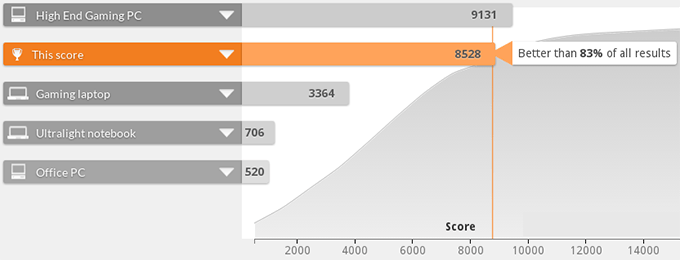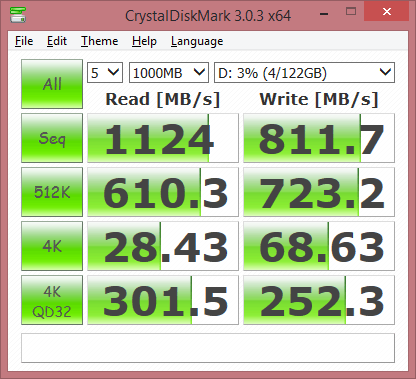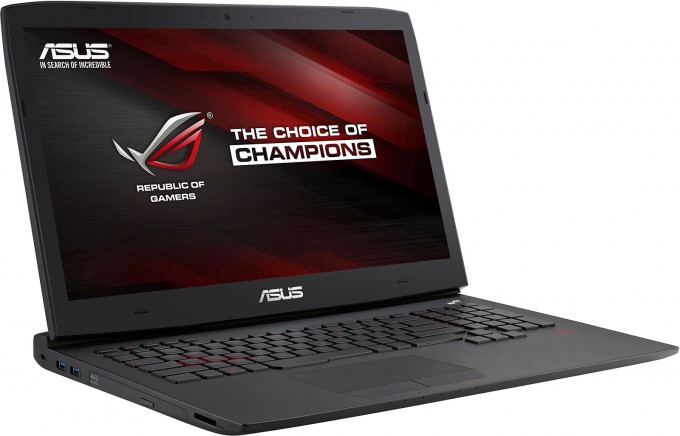- Qualcomm Launches Snapdragon 4 Gen 2 Mobile Platform
- AMD Launches Ryzen PRO 7000 Series Mobile & Desktop Platform
- Intel Launches Sleek Single-Slot Arc Pro A60 Workstation Graphics Card
- NVIDIA Announces Latest Ada Lovelace Additions: GeForce RTX 4060 Ti & RTX 4060
- Maxon Redshift With AMD Radeon GPU Rendering Support Now Available
ASUS Republic of Gamers G751JY 17-inch Gaming Laptop Review

There are gaming laptops, and then there are uncompromising gaming laptops. ASUS’ ROG G751JY falls into the latter category for a number of different reasons, with a great one being that it packs some seriously powerful hardware under its hood. How does a 1GB/s SSD sound? 24GB of RAM? GTX 980M? Exactly. Read on!
Page 4 – System Performance & Final Thoughts
The previous two pages did a great job of highlighting the real-world gaming capability of the G751JY, and on this page, I’d like to tackle the 3DMark and system performance. Following that, we’ll wrap things up with some final thoughts.
Ignoring the weaker 3DMark tests, let’s single out Fire Strike. On the G751JY, a score of 8,529 is attained, which as can be seen in the shot below, puts it right behind what Futuremark considers to be a high-end gaming PC.
A standalone 3DMark score doesn’t matter much, so note this: the last time I benchmarked the GTX 770, it scored about 7,000. The GTX 780? 8,700. Yup – the GTX 980M is one hell of a fast mobile graphics card.
 (Click to see the official result.)
(Click to see the official result.)
Up next is PCMark 8 with another set of results that are hard to gauge the worth of without a basis for comparison. What’s worth noting here is that Intel’s mainstream CPUs deliver incredible all-around performance, and in tests like PCMark, they can even outperform its enthusiast models. Here’s some proof: look back to my look at Intel’s Core i7-5960X eight-core processor, and you can see that it’s the G751JY’s i7-4710HQ that scores a couple of hundred points higher in each test.
| ASUS G751JY – Futuremark PCMark 8 | ||
| Run #1 | Run #2 | |
| Home | 4776 | 5166 |
| Work | 5245 | 5397 |
| Creative | 5378 | 5625 |
| Storage | 5014 | 5012 |
One thing that helps the G751JY perform so well in any benchmark that stresses the I/O is its Samsung XP941 M.2 PCIe-based SSD. Using CrystalDiskMark, I clocked this SSD at 1.1GB/s read and 811MB/s write. The results seen in the shot below are about double what we’d see from a regular 2.5-inch enthusiast SSD. If you never put much thought into owning a PCIe SSD in the past, these results should increase the intrigue.

Wrapping-up the test results, we’ll turn our attention to yet another Futuremark suite, Powermark. Powermark’s goal is to accurately stress a notebook under realistic scenarios to gauge what to expect from its battery-life. For testing, the LAN, Wi-Fi, and Bluetooth are all disabled, and the Balanced power scheme in Windows 8.1 is used. That puts the screen brightness to about 60%, which I considered to be suitable for use when on battery.
| ASUS G751JY – Futuremark Powermark | ||
| Run #1 | Run #2 | |
| Balanced | 2 hours 46 minutes | 2 hours 38 minutes |
| Productivity | 3 hours 11 minutes | 3 hours 11 minutes |
| Entertainment | 2 hours 5 minutes | 2 hours 18 minutes |
Being a true gaming notebook, it’d be crazy to expect impressive battery-life out of the G751, but I admit the results strike me as impressive. For regular use on a seriously powerful gaming notebook to attain over 3 hours of battery-life is definitely suitable. Beyond that, the use is going to be limited, although because of its size, that’s basically implied anyway (you’re not hauling this out on a plane unless it happens to be a private jet).
Final Thoughts
The G751JY is one of the easiest products I’ve ever had to write a conclusion for. It helps that it packs a massive punch while managing to not do too much wrong. It’s without question an excellent choice for someone who’s serious about their games and regularly games on-the-go.
In the 3DMark section above, I mentioned that Futuremark pits the G751JY right underneath a “high-end gaming desktop”, and after using the notebook for over a month, I agree with that placement. The G751JY feels faster than my full-blown desktop in many ways thanks to its included PCIe-based SSD. This was my first experience with such an SSD, and I’m now decided that I’ll get one in the future. These drives are so fast that it’s actually made me think less of standard 2.5-inch SSDs. I am not sure if I should be ashamed or come down off cloud nine, but really – the SSD in this notebook is twice as fast as a standard desktop SSD.
And to think, these M.2 drives get even faster.
It’s not just benchmarking numbers I base all of this off of, it’s real-world use. I ran virtual machines on this notebook just as well as I run them on my desktop, and even after a solid month of using the same OS install, it still feels as fast as it did when I first boot it up.
And that’s not even talking about the gaming performance. As mentioned in the last section, the GTX 980M, according to 3DMark, is about 3% slower than a desktop GTX 780. AKA: it’s fast. It’s so fast that it would have done the notebook injustice to refrain from testing on an external monitor. 1080p is truly a cakewalk for the G751JY.
As for the rest of the hardware, the keyboard and touchpad (not so much its buttons) are both great to use, and the macro keys as well as the ShadowPlay record key are nice additions. Beyond that, there’s quite a bit of I/O connectivity on the sides, including 4x USB 3.0 ports.
What more needs to be said? This is a monstrous gaming notebook that I can’t find a real fault with. You can game for hours without slowdown (or uncomfortable noise at full-tilt), and it’s overall a comfortable notebook to use. Of course, $2,250 isn’t cheap. If $1,499 is a little more attractive, you can get the G751JT which retains the same CPU but drops the GPU to 970M, RAM to 16GB, and forgoes both the super-fast PCIe SSD and Blu-ray writer (instead including a DVD-RW).
This is one of the easiest Editor’s Choice awards I’ve ever given out.
Pros
- It’s a notebook that feels as powerful as a gaming desktop.
- Native 1080p gaming is no problem for the GTX 980M. Handles external 1440p gaming very well.
- NVIDIA technologies (G-SYNC, ShadowPlay, etc) all work great.
- Tons of RAM and super-fast SSD.
- Game recording button is a nice touch.
- Lots of connectivity options.
Cons
- Touchpad buttons are mushy and unsatisfying to push.
- Some might have preferred to see a 1440p display.
- Some may not like the game record button and macros being so close to the Esc and F keys.

ASUS G751JY Gaming Notebook
Support our efforts! With ad revenue at an all-time low for written websites, we're relying more than ever on reader support to help us continue putting so much effort into this type of content. You can support us by becoming a Patron, or by using our Amazon shopping affiliate links listed through our articles. Thanks for your support!






